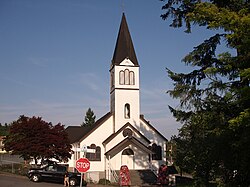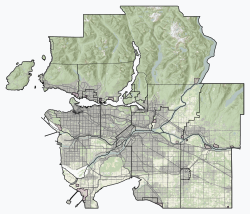Maillardville
Maillardville | |
|---|---|
 Notre Dame de Lourdes Church on Laval Square | |
Location of Maillardville within Metro Vancouver | |
| Coordinates: 49°14′15″N 122°52′01″W / 49.2374°N 122.867°W | |
| Country | |
| Province | |
| Region | Lower Mainland |
| Regional district | Metro Vancouver |
| City | Coquitlam |
| Named for | Edmond Maillard |
| Government | |
| • Mayor | Richard Stewart |
| • MP (Fed.) | Bonita Zarrillo (NDP) |
| • MLA (Prov.) | Selina Robinson (NDP) |
| Population | |
| • Total | 15,837 |
| Time zone | UTC−8 (PST) |
| • Summer (DST) | UTC−7 (PDT) |
| Postal code span | V3K |
| Area codes | 604, 778, 236, 672 |
| Website | maillardville |
Maillardville is a community on the south slope of the city of Coquitlam, British Columbia, Canada.
History
[edit]In 1889, Frank Ross and James McLaren opened what would become Maillardville, a $350,000, modern lumber mill on the north bank of the Fraser River which created a mill town of 20 houses, a store, post office, hospital, office block, barber shop, pool hall and a Sikh temple[4] had grown around the mill.[5] A mill manager's residence was built that later became Place des Arts.[6] A second mill manager's residence was built in 1909 and is now known as Mackin House, a historic house museum operated by the Coquitlam Heritage Society.
In 1909, Ross and McLaren, in search of workers for the Canadian Western Lumber Company, recruited a contingent of 110 French Canadian mill workers from Eastern Ontario and Quebec.[7] Approximately 40 French Canadian families settled in present-day Maillardville in 1909, with another contingent arriving in June 1910.[7] Named for Father Edmond Maillard, a young Oblate from France, it became the largest Francophone centre west of Manitoba.[8] Similarly, in the early 1900s, many Punjabis came to work in the mills and settled on the south slope of Coquitlam.[4]
In 1971, the City of Coquitlam and the Village of Fraser Mills were amalgamated, which gave the city a larger tax base. The mill closed in 2001, and is now rezoned into a residential area.[6] Maillardville's past is recognized today in street names, the Francophone education system and French immersion programs, French-language guides and scouts, and celebrations such as Festival du Bois.[9]
Maillardville celebrated its 100th birthday in 2009.[10]
In 2014, the City of Coquitlam updated the Maillardville neighbourhood plan. The city anticipates a population growth of 6,000 over the next two decades.[11]
Geography
[edit]Maillardville is bordered by Austin Avenue to the north and Lougheed Highway to the south. To the west it is flanked by Blue Mountain Street, while to the east it is bordered by Mundy Road. The town centre of Maillardville is situated in the southwest corner of the neighbourhood, on Brunette Avenue between Lougheed Highway and Woolridge Street.[12]
Demographics
[edit]Population
[edit]| Year | Pop. | ±% |
|---|---|---|
| 1991 | 11,978 | — |
| 1996 | 12,873 | +7.5% |
| 2001 | 13,822 | +7.4% |
| 2006 | 14,005 | +1.3% |
| 2011 | 14,779 | +5.5% |
| 2016 | 14,975 | +1.3% |
| 2021 | 15,837 | +5.8% |
| Source: Statistics Canada [13][14][15][16][17][18][19][20][21][22][23][24][1][2][3] | ||
Ethnicity
[edit]| Panethnic group | 2021[1][2][3] | 2016[22][23][24] | 2011[19][20][21] | 2006[17][18] | 2001[15][16] | 1996[14][16] | ||||||||
|---|---|---|---|---|---|---|---|---|---|---|---|---|---|---|
| Pop. | % | Pop. | % | Pop. | % | Pop. | % | Pop. | % | Pop. | % | |||
| European[a] | 7,385 | 46.93% | 7,905 | 53.63% | 8,845 | 60.48% | 9,545 | 68.92% | 10,095 | 74.06% | 9,770 | 76.96% | ||
| East Asian[b] | 3,610 | 22.94% | 2,825 | 19.17% | 2,270 | 15.52% | 1,880 | 13.57% | 1,650 | 12.11% | 1,190 | 9.37% | ||
| South Asian | 1,350 | 8.58% | 980 | 6.65% | 800 | 5.47% | 710 | 5.13% | 455 | 3.34% | 690 | 5.44% | ||
| Southeast Asian[c] | 1,255 | 7.98% | 1,275 | 8.65% | 975 | 6.67% | 645 | 4.66% | 600 | 4.4% | 420 | 3.31% | ||
| Middle Eastern[d] | 675 | 4.29% | 475 | 3.22% | 560 | 3.83% | 285 | 2.06% | 265 | 1.94% | 90 | 0.71% | ||
| Indigenous | 390 | 2.48% | 445 | 3.02% | 455 | 3.11% | 225 | 1.62% | 230 | 1.69% | 230 | 1.81% | ||
| Latin American | 330 | 2.1% | 280 | 1.9% | 155 | 1.06% | 200 | 1.44% | 105 | 0.77% | 105 | 0.83% | ||
| African | 310 | 1.97% | 245 | 1.66% | 360 | 2.46% | 225 | 1.62% | 175 | 1.28% | 95 | 0.75% | ||
| Other/multiracial[e] | 445 | 2.83% | 295 | 2% | 205 | 1.4% | 135 | 0.97% | 60 | 0.44% | 90 | 0.71% | ||
| Total responses | 15,735 | 99.36% | 14,740 | 98.43% | 14,625 | 98.96% | 13,850 | 98.89% | 13,630 | 98.61% | 12,695 | 98.62% | ||
| Total population | 15,837 | 100% | 14,975 | 100% | 14,779 | 100% | 14,005 | 100% | 13,822 | 100% | 12,873 | 100% | ||
| Note: Totals greater than 100% due to multiple origin responses. | ||||||||||||||
Language
[edit]| Language | % |
|---|---|
| English | 59.5% |
| Korean | 5.1% |
| Mandarin | 4.7% |
| Cantonese | 4.7% |
| Tagalog | 4.1% |
| Punjabi | 3.2% |
| Persian | 2.4% |
| French | 1.8% |
| Other | 14.6% |
| Total % | 100% |
Media
[edit]They Dream, a Canadian feature-length film, set in and around Maillardville, including Place des Arts and Mackin House Museum, was shot over the summer of 2012. Written and directed by Vancouver filmmaker Gord Stanfield, They Dream is the story of a 20-year-old art student, David Dubois, his love affair with a mysterious woman Lisa Reese, and his tragic past. Jean Ory reminds David he can't escape the truth. Lisa and Jean were lifetime residents of Maillardville. They Dream's lead cast includes Jason Mireau, Delia Tatiana and Moishe Teichman.
Notable people
[edit]- Lucille Starr, who was inducted to the Canadian Country Music Hall of Fame in 1987 began her musical career in Maillardville with the group Les Hirondelles. A street in Coquitlam "Lucille Starr Way" is named in her honour.
- Shawn Farquhar, magician
See also
[edit]Notes
[edit]- ^ Statistic includes all persons that did not make up part of a visible minority or an indigenous identity.
- ^ Statistic includes total responses of "Chinese", "Korean", and "Japanese" under visible minority section on census.
- ^ Statistic includes total responses of "Filipino" and "Southeast Asian" under visible minority section on census.
- ^ Statistic includes total responses of "West Asian" and "Arab" under visible minority section on census.
- ^ Statistic includes total responses of "Visible minority, n.i.e." and "Multiple visible minorities" under visible minority section on census.
References
[edit]- ^ a b c Government of Canada, Statistics Canada (15 November 2023). "Census Profile, 2021 Census of Population Profile table 9330282.01 British Columbia [Census tract]". www12.statcan.gc.ca.
- ^ a b c Government of Canada, Statistics Canada (15 November 2023). "Census Profile, 2021 Census of Population Profile table 9330282.02 British Columbia [Census tract]". www12.statcan.gc.ca.
- ^ a b c Government of Canada, Statistics Canada (15 November 2023). "Census Profile, 2021 Census of Population Profile table 9330281.02 British Columbia [Census tract]". www12.statcan.gc.ca.
- ^ a b Eagland, Nick (7 April 2019). "Sikh Heritage Month: The South Asian pioneers of Fraser Mills". Vancouver Sun. Archived from the original on 12 April 2019. Retrieved 18 April 2019.
- ^ "Maillardville". Heritage BC. Retrieved 4 October 2024.
- ^ a b Fraser Mills: HistoryArchived 13 October 2008 at the Wayback Machine Retrieved 15 February 2009
- ^ a b Kenny, Nicolas (14 June 2019). "Francophones of British Columbia". In Cooper, Celine (ed.). The Canadian Encyclopedia. Historica Canada. Archived from the original on 27 April 2020. Retrieved 23 April 2020.
- ^ City of Coquitlam: History and Heritage Archived 23 February 2009 at the Wayback Machine Retrieved 15 February 2009
- ^ CitySoup.ca: Coquitlam Regional History Archived 5 August 2009 at the Wayback Machine Retrieved 15 February 2009
- ^ Maillardville100.com: 100 Years of History Archived 28 February 2009 at the Wayback Machine Retrieved 22 February 2009
- ^ "Maillardville Neighbourhood Plan". City of Coquitlam. Archived from the original on 30 November 2022. Retrieved 15 November 2022.
- ^ "Maillardville Community Profile". City of Coquitlam. Archived from the original on 15 November 2022. Retrieved 15 November 2022.
- ^ "Tri-Cities Community Profile" (PDF). Archived (PDF) from the original on 18 April 2019. Retrieved 18 April 2019.
- ^ a b Government of Canada, Statistics Canada (4 June 2019). "1996 Census of Canada: Electronic Area Profiles Profile of Census Tracts". www12.statcan.gc.ca. Retrieved 22 September 2024.
- ^ a b Government of Canada, Statistics Canada (23 December 2013). "2001 Census Area Profiles Profile of Citizenship, Immigration, Birthplace, Generation Status, Ethnic Origin, Visible Minorities and Aboriginal Peoples, for Census Metropolitan Areas, Tracted Census Agglomerations and Census Tracts, 2001 Census". www12.statcan.gc.ca. Retrieved 21 September 2024.
- ^ a b c Government of Canada, Statistics Canada (23 December 2013). "Population and Dwelling Counts for Census Metropolitan Areas, Census Agglomerations and Census Tracts, 2001 and 1996 Censuses - 100% Data". www12.statcan.gc.ca. Retrieved 21 September 2024.
- ^ a b Government of Canada, Statistics Canada (23 July 2020). "2006 Census Tract profiles Census tract profile for 0282.00 (CT), Vancouver (CMA) and British Columbia". www12.statcan.gc.ca.
- ^ a b Government of Canada, Statistics Canada (23 July 2020). "2006 Census Tract profiles Census tract profile for 0281.02 (CT), Vancouver (CMA) and British Columbia". www12.statcan.gc.ca.
- ^ a b Government of Canada, Statistics Canada (27 November 2015). "NHS Profile, 9330282.01, British Columbia, 2011". www12.statcan.gc.ca.
- ^ a b Government of Canada, Statistics Canada (27 November 2015). "NHS Profile, 9330282.02, British Columbia, 2011". www12.statcan.gc.ca.
- ^ a b Government of Canada, Statistics Canada (27 November 2015). "NHS Profile, 9330281.02, British Columbia, 2011". www12.statcan.gc.ca.
- ^ a b Government of Canada, Statistics Canada (8 February 2017). "Census Profile, 2016 Census – 9330282.01 [Census tract], British Columbia and Vancouver [Census metropolitan area], British Columbia". www12.statcan.gc.ca.
- ^ a b Government of Canada, Statistics Canada (8 February 2017). "Census Profile, 2016 Census – 9330282.02 [Census tract], British Columbia and Vancouver [Census metropolitan area], British Columbia". www12.statcan.gc.ca.
- ^ a b Government of Canada, Statistics Canada (8 February 2017). "Census Profile, 2016 Census – 9330281.02 [Census tract], British Columbia and Vancouver [Census metropolitan area], British Columbia". www12.statcan.gc.ca.
- ^ Government of Canada, Statistics Canada (8 February 2017). "Census Profile, 2016 Census - 9330282.01 [Census tract], British Columbia and Vancouver [Census metropolitan area], British Columbia". www12.statcan.gc.ca. Archived from the original on 31 July 2021. Retrieved 15 November 2022.
- ^ Government of Canada, Statistics Canada (8 February 2017). "Census Profile, 2016 Census - 9330282.02 [Census tract], British Columbia and Vancouver [Census metropolitan area], British Columbia". www12.statcan.gc.ca. Archived from the original on 15 November 2022. Retrieved 15 November 2022.
- ^ Government of Canada, Statistics Canada (8 February 2017). "Census Profile, 2016 Census - 9330281.02 [Census tract], British Columbia and Vancouver [Census metropolitan area], British Columbia". www12.statcan.gc.ca. Archived from the original on 15 November 2022. Retrieved 15 November 2022.

